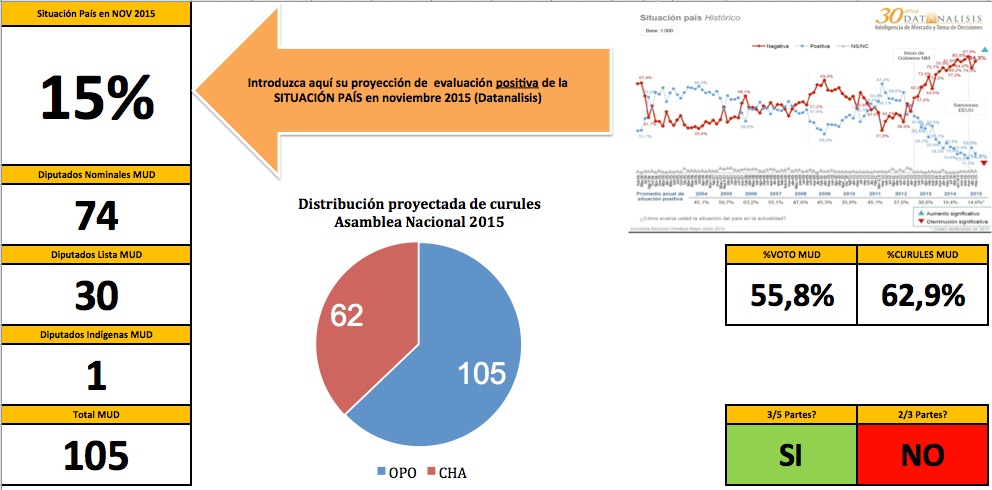Forecasting the 2015 National Assembly Elections



This is just one scenario: the real fun comes from twiddling the knobs, so download yours today.
Is it possible to forecast how many seats the government and the opposition will get in the National Assembly on the basis of National-level polls? It’s a tough problem, but ahead of the 2010 National Assembly election, we showed it can be done.
And this year, with a little help from our friends over at Distortioland, we’re trying it again.
The problem is tough, and not necessarily for the reason you’re thinking. Venezuela’s Mixed Member Proportional Representation System for National Assembly elections is complex, blending 87 districts with Westminster-style first-past-the-post constituencies with a “proportional” element based on state-by-state candidate rosters that are themselves non-standard. (More about “las morochas” some other time.) Then there are specially set aside seats for representatives of indigenous groups…it’s a mess.
In a way, it isn’t one election: it’s 87 separate elections all carried out on the same day. Or, if you prefer, 111 elections, since you could consider the state-by-state list contests elections in their own right. Trouble is, we don’t have 111 separate polls: we have one poll, which shows voting trends at the national level. Is there any way to square this forecasting circle?
It’s hard but, despite what some might tell you, it’s not impossible. You can say something useful about circuit-by-circuit shifts on the basis of nationwide trends. Because while voters don’t move in lockstep with one another across all districts, changes in voting intentions are definitely correlated with one another from one region to another.
When people’s perceptions of how the country is doing overall worsen, their propensity to vote for the governing party falls. It doesn’t fall by the same proportion everywhere, but it does tend to fall everywhere.
Did you ever wonder why pollster are always keen to ask generic “is the country headed in the right direction?” type questions? This is the reason right here. Generic questions can tell us a lot about underlying voting trends. That’s PoliSci 101.
Clearly, the opinion climate is awful all around Venezuela right now, and governing parties generally pay a heavy price for that on election day. That doesn’t mean the opposition will win everywhere: some voting districts are so solidly pro-government that they are impervious to any national opinion fluctuation. Even factoring in these outliers, the opinion climate-voting intention correlation is stable enough to be predictable in a systematic way.
That’s the theory behind our Legislative Election Estimator Tool: changing national opinion trends have a predictable impact on circuit-by-circuit voting patterns. What the Estimator Tool does is calculate that relationship, and package it into a little Micosoft Excel sheet you can play with.
Developed by our friend @Econ_Vzla over at Distortioland, the tool uses Datanalisis’ “Situacion del Pais” question as an independent variable. You input your forecast of that on the upper-left side corner, then the tool calculates what impact different opinion climates are likely to have on vote distributions and – crucially, A.N. seat distributions.
In technical terms, what Distortioland did is calculate, circuit-by-circuit, the elasticity of the vote with respect to positive perceptions of the country’s situation, as measured by Datanalisis. (A more detailed description can be found over there.) If you really want to jump into the weeds, you can click on the “Hood” tab and see what a given level of Positive Perception implies for results in each circuit – though those results are much less reliable than the global one.)
In Datanalisis’s latest poll, just under 13% of the people surveyed said the country’s situation was on the positive side. But we were feeling generous, so we gave the government a two-point head start: by default, the Tool shows you how the election would turn out if the share of people perceiving that the country’s situation is “positive” rises to 15%.
This Tool is far from perfect, of course. It’s really very simple. It uses a single input variable. If you were so minded, you could construct a much more elaborate tool that uses multiple inputs, each of which is known to be correlated with voting intentions (GDP growth, inflation, presidential popularity, unemployment, etc. etc.) We decided to keep it simple.
To be sure, the Tool isn’t some crystal ball. It can’t account for self-coups or massively-greater-than-in-previous-elections outbreaks of fraud. It can’t account for idiosyncratic variables such as splits within either of the camps in a given circuit, or candidate quality. All it does is express the impact of a stable statistical relationship between a given public opinion scenario and circuit-by-circuit vote shares. It will make mistakes in some circuits, which we expect to cancel one another out. If all works well, it will be much more accurate globally – at forecasting the overall distribution of seats between the government and the opposition – than locally, at forecasting the outcome of any given race.
With all that said, in 2010 an even simpler Forecasting Tool did rather well. Let’s see how it goes this time.
Caracas Chronicles is 100% reader-supported.
We’ve been able to hang on for 22 years in one of the craziest media landscapes in the world. We’ve seen different media outlets in Venezuela (and abroad) closing shop, something we’re looking to avoid at all costs. Your collaboration goes a long way in helping us weather the storm.
Donate




